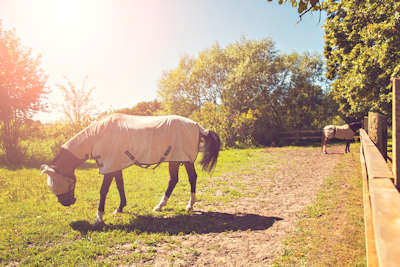Tips For Choosing a Horse Blanket
** Affiliate disclosure. This web site is supported by its awesome audience. When you click or purchase through links on our site, we may earn an affiliate commission.

Before purchasing a horse blanket, consider a few factors. Among them is the weight and denier. The length should also be taken into consideration. The blanket should be long enough to cover your horse’s rump. The blanket should end just above the start of the tail. There are other factors to consider, such as color, design, and drop. The following tips can help you find the perfect horse blanket. But before you begin shopping for one, be sure to read these tips first.
Check here to compare prices on the top blankets for horses.
Weight
The weight of a horse blanket will depend on your horse’s coat and environment. In the winter, an unclipped horse may not require a blanket at all. However, body-clipped horses may require a heavier blanket in the cold months. Depending on the breed of your horse, the blanket’s weight will also determine how warm it is for your horse. Here are some tips for choosing the right blanket for your horse.
First of all, you should consider the weather where you live. If the temperatures drop below forty degrees Fahrenheit, you may want to consider a lightweight blanket. But if the temperatures drop below twenty degrees Fahrenheit, a heavy blanket will keep your horse toasty warm. It is important to choose the right weight for your horse. You can use a handy chart to determine which blanket will best keep him warm. And keep in mind that a heavy blanket is also recommended if your horse will spend the majority of the winter outdoors.
Another factor to consider is the denier. This measure describes the toughness of the outer layer of the blanket. The higher the denier, the tougher the blanket. High-denier blankets are best if you plan on letting your horse play around other horses. They will not tear as easily. A stable blanket will see less wear overall, so a high denier will last longer. That’s why it’s crucial to check the denier before buying a blanket for your horse.
Check here to compare prices on the top blankets for horses.
Denier
If you are planning to buy a new horse blanket, you should pay special attention to the density of the material. Denier, a measurement of the thickness of nylon threads, is a measure of durability. Higher denier blankets are more resilient, heavier, and windproof. However, don’t forget to check the weight as well. A heavy blanket is likely to cause your horse more discomfort and irritation. When choosing the right denier, make sure to consider the type of use your blanket will have.
Besides denier, you should also check the neck style of the blanket. While a standard neck sits right below the neck, a full neck is a bit different, with an extra piece behind the horse’s ears. This extra piece can be attached permanently to the body of the blanket or removable, and both options provide additional coverage. Denier is the measure of the outer fabric. The higher the number, the tougher the blanket is.
The heavier the blanket, the thicker it is. Choose a heavier weight blanket if your horse tends to be prone to heat. Higher denier blankets are more durable than lighter blankets. If your horse’s coat is extremely thick, consider a blanket with a higher denier. For example, a heavyweight blanket with 400 grams of fill is a better choice than a lightweight one. A blanket’s denier will be higher if it is more durable and water-resistant.
Color
There are three basic types of horse blankets: sheets, stable blankets, and turnout blankets. The type you choose should depend on the climate and the time of year. For warmer climates, lightweight blankets are sufficient to keep your horse warm. If your horse spends most of his time outdoors, you may need a heavier, weatherproof blanket. Choosing the right blanket color for your horse will depend on your needs and preferences.
When choosing a horse blanket, you’ll want to consider its durability and waterproofing. You can always re-waterproof your horse blanket using a specific wash, but it is not always effective. Another important factor is the color. Some barns only allow certain colors, and don’t want to see wild patterns on their blankets. Brighter blankets, however, may be useful during hunting season. You should also consider the weather conditions in your barn.
A horse blanket may not have surcingles. These straps cross over the horse’s back legs to prevent the blanket from shifting. A horse blanket with gussets prevents shifting and offers more comfort for your horse. Some blankets may have a wide gusset in the back, so your horse will be less likely to rub it. Also, be sure to check the material of the blanket. The lining can be made of cotton, nylon, or a blend of both.
Drop
Before you purchase a horse blanket, you need to make sure it fits the animal. It should have a drop that fits comfortably over the horse’s withers, and the length should be approximately a foot shorter than the horse’s head. If you’re unsure of the proper length, measure your horse’s withers with a tape measure. Be sure to round the measurement up to the next full-sized blanket, or use a ruler to get the exact measurements.
The fill in your horse blanket determines how warm it is. There are two types of fill: Polyfill and Fiberfill. These fills are measured in grams, and the higher the number, the warmer your blanket will be. Also, keep in mind your horse’s environment and coat condition. Depending on your climate, your horse may need a lighter, thinner, or thicker blanket, so make sure to keep this in mind when selecting a blanket.
Another factor to consider when buying a horse blanket is the denier. The higher the denier number, the stronger the blanket’s outer layer is. Having a high denier rating is important if your horse shares a stable with other horses, as this means less wear and tear on the blanket. However, a lower denier count may be fine for horses that are not likely to rub against the blanket. If your horse has a rough coat, a higher denier may be a better choice, while a low-denier blanket will be sufficient for a pony that doesn’t use the blanket very much.
Length
The length of a horse blanket is a very important measurement. There are different types, and the size of a blanket will depend on the weather. A blanket’s length should be 78 inches long. In general, blankets run in two-inch increments, but you should add an inch or two if your horse falls in between two sizes. The length of a horse blanket can also vary significantly, depending on its weight and fabric.
The length of a horse blanket is determined by how deep the blanket covers the horse’s barrel. You’ll want to get one that covers the entire barrel, without being too loose or limiting movement. Measure the length from the front of the withers to the middle of the chest, ensuring the blanket is not too low or too high. The gusset should be closed when you measure the length. When measuring, you’ll need to get a tape measure.
The measurement of a horse blanket can be found on a weight tape. Use it to measure the horse’s shoulder and neckline. Make sure that you do not place the tape too high or too low to avoid getting tangled. Once you’ve measured the shoulder area, you can add the length to find out the blanket’s length. When measuring the length of a blanket, use inches instead of centimeters.
Durability
The quality and durability of your horse blanket will determine its cost and lifespan. You can save money by purchasing a durable blanket and replacing it only when necessary. If you have a horse that is very rough on blankets, you should consider investing in a higher denier material. A nylon outer shell will help prevent a hole from spreading, and rip-stop nylon is a high-denier material. Other options include linings made from cotton, poly/cotton blends, or mesh that helps manage moisture and air flow.
A good horse blanket should be able to keep your horse comfortable during exercise or transport. If it gets wet, it can weigh down your horse and put unnecessary strain on his back. If you need to travel, consider purchasing a blanket that is made of nylon or ripstop poly. These blankets are strong, durable, and cost a lot less than other blankets. You should also look for a blanket with reinforced stitching and taped seams to prevent fraying.
While deciding on a horse blanket, take time to learn about its features and durability. The best blankets offer waterproofing capabilities and flexibility. Reinforced corners are also important for horse comfort. Horse blankets that are more flexible and lightweight will help your horse move more freely without being constricted. Listed below are some features that should be considered when purchasing a horse blanket. Don’t forget to compare the prices online.
Price
There are various factors that go into determining the price of a horse blanket. The type of insulation, also known as fill, determines the weight of a blanket. Fill is a combination of fibers or polyfill and is measured in grams. The higher the gram weight, the warmer the blanket. Here are some factors to consider:
First, determine the size of the blanket. Standard blanket sizes range from 64 inches for small ponies to 90 inches for large draft horses. Measure the horse correctly so that you purchase the proper size. A horse that is approximately 75 to 78 inches tall should wear a 64-78 inch blanket. If your horse is taller than average, consider purchasing a blanket that is half an inch smaller. You can get a blanket of a different size for a more expensive price, but be aware that it will require some extra work.
Choose a blanket with gussets. Gussets help lift the blanket off the horse’s withers and reduce rubbing. Gussets are excellent for protecting the horse’s tail. They can also eliminate pressure points and rubs caused by tight blankets. A good blanket will not be saggy or abrasive. The design of the blanket should be comfortable for the horse. A gusseted blanket will be more flexible and allow your horse to move more freely.

Sarah is the lead content developer at HorseKids.com She also writes in the pet and wellness space. On HorseKids.com Sarah specializes in covering the top products for horse lovers and DIY tips and articles.